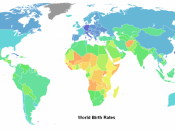Doing Business in the Pacific Basin.
Japan is facing rapid population aging. It is not new, of course, that Japan's
population is growing older -- it has the lowest birthrate of any developed nation,
almost no immigration and one of the longest-living populations. By the year
2025, the proportion of those 65 and over will be highest in Japan, followed by
Italy and Hong Kong. Among all the industrial nations, Japan will be the oldest in
the entire world.
There are several factors that have caused this situation. Between 1947 and
1949 Japan had a baby boom. The Japanese baby boom was very short and
after that the birth rate declined dramatically. This a brief amount of time
compared to the baby boom of the U.S. (1946-1964)
During the first half of the 1950s, three-quarters of pregnancies ended in
abortion. In the second half, 50% of pregnancies were aborted. And in the first
half of the 1960s pregnancies were prevented with contraceptives.
In 1966. Births dropped dramatically. Why? Because it was the year of the fire
horse, and according to Japanese superstition, girls born in that year will have
very unhappy lives, and most likely will kill their husbands. For that reason
parents tried to avoid births. They either had babies the year before
that or the year after that year.
In 1970, a large number of births were averted with contraceptives and abortion.
But in the recent past, the pattern is different. The proportion of singles has been
rising dramatically in the last 20 years. The source of declining fertility is different.
Marriage patterns have been changing. It is one of the silent revolutions
underway in Japan. According to the 1985 population census, 30% of women in
their late 20s were single, in 1990, five years later it was...


